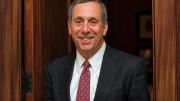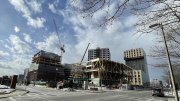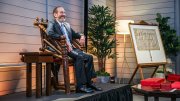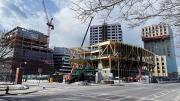Recently we dedicated the new ArtLab in Allston. Located on North Harvard Street between the Business School and Western Avenue, this jewel of a building is a microcosm of what I envision for Allston: a hive of creativity and collaboration, where Harvard students and faculty join community members to do research, teach and learn, and—in the case of the ArtLab—create stunning art. The ArtLab is already holding classes, hosting exhibits and performances, and drawing visitors from both sides of the river.
It is my hope that Allston will be a place where art, culture, engineering, science, and industry are part of the fabric of the community. Just as Kendall Square has energized East Cambridge, we hope that the lively 24-hour neighborhood we are building in Allston will generate research, provide stellar teaching and learning opportunities, and bring economic growth to the region.
For many years, Allston was just an idea, a vision of the future, but that future is rapidly coming into focus. The i-Lab, the Launch Lab X, and the Pagliuca Harvard Life Lab attract countless Harvard students, faculty, and alumni each day. About a third of all undergraduates spend time at the i-Lab during their four years at the College. At the Business School, Xander University Professor Doug Melton and Anne T. and Robert M. Bass Professor of Government Michael Sandel teach the largest undergraduate course at Harvard, “Tech Ethics,” and Paul Whiton Cherington Professor David Moss teaches a very popular undergraduate course on democracy. And, of course, our student athletes have been crossing the river for years to compete on the gridiron or in the pool.
Before long, the American Repertory Theater (A.R.T.) will join the ArtLab on North Harvard Street. Thanks to a transformative gift from David and Stacey Goel, the beloved A.R.T. is finding a new home. Diane Paulus, Terrie and Bradley Bloom Artistic Director of the A.R.T., envisions the venue as something like a “teaching hospital” for theater, where students will work with faculty to create new dramatic forms for the 21st century.
And next fall the new Science and Engineering Complex will open, and another 20 percent of our students will cross the river each day to attend classes, do research, and push the boundaries of inquiry and discovery. It is fitting that a large portion of the Harvard John A. Paulson School of Engineering and Applied Sciences will be located in Allston. At the end of the 19th century, then-president of Harvard Charles William Eliot tried to acquire MIT! Eliot wanted to move it to Allston, close to where the Business School is now. More than a century later, we are realizing Eliot’s vision of a major Harvard engineering presence in Allston.
Beyond providing space for Harvard to grow, Allston also creates opportunities for us to collaborate with industry and our neighboring universities in new and interesting ways. We are working with MIT and Boston University to explore housing options in the area for faculty and graduate students from all three institutions. Shortly we will name a developer to help us create office and laboratory space in our Enterprise Research Campus. We also plan to build a new hotel and conference facility to serve our growing need for executive education facilities.
Not least of all, I am excited by the opportunity to engage our neighbors from the community. For several years, students from the College have taught kids from the neighborhood through the Harvard Ed Portal. Later this fall we will re-dedicate William F. Smith Field, a collaborative project with the Boston Parks Department that gives kids better recreational opportunities. We are also working with the city and the neighborhood to create a new multi-use greenway that will extend from the library in Allston all the way to the Charles River.
For most of us, our college experience is tied inextricably to a sense of place. For future graduates of Harvard, that sense of place will likely meld iconic Cambridge with the vibrancy of Allston. I encourage you to come back to see our bold new campus taking shape.









